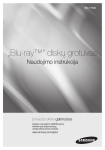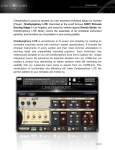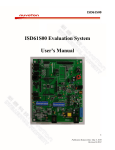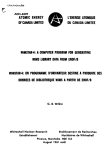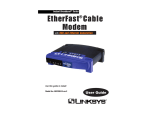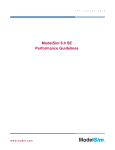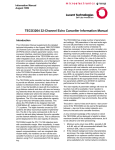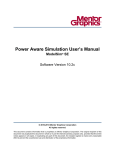Download MN1000-2W Micronode with FP return
Transcript
MN1000-2W Mini Optical Node MN1000-2W Mini Optical Node User’s Manual QUALITY FIBER AND RF, INC HTTP://WWW.QFRF.COM Address: 8941 SE Duncan St PHONE:772-545-9757 EMAIL: [email protected] Hobe Sound, FL 33455 General Introduction MN1000-2W is a next-generation optical node for use in bi-directional optical fiber and CATV network systems. It is an ideal terminal for HFC or FTTx systems, containing one optical receiving module and one transmitting module. The MN1000-2W Mini Node is very compact in size with high performance and high reliability. Precautions 、 、 、 ! 1 Please read this complete user manual before installation or operation of this unit. 2 Power supply: For your safety, DO not touch any connector end of power supply 3 Power cord protection Install the power adapter in a safe place without any other object on it. Pay careful attention to the proper routing of the power cable to the receiver. 4 Avoid leakage of any liquid, including rain or snow. Do not remove the screws on the shell to prevent moisture damage. 、 Block Diagram Operation explanation 、 、 1 When power supply is plugged in the red indicator of POWER should be lit. 2 Downlink receiving parts a. Test the optical receive power with an optical power meter. Typical input power is -1 to +2.0dBm. b. Connect fiber to the fiber adapter at the downlink end of optical receiver. When the "OPTICAL POWER" indicator turns green that shows you have acceptable optical input power. The alarm indicator turns red if the input optical power is over than 2dBm. c. Testpoint level is 20dB lower than output port. 3 Uplink Parts a. When the Green Indicator is lit that means the optical transmitter module is working well. 、 : MN1000-2W Mini Optical Node b. Ensure that the Return RF Drive level is no more than 15dBmV. c. Testpoint signal level is 20dB lower than the return signal input port. d. Connect the return path fiber to the fiber adapter. 11. RF Output Port 1.Power In Port 2.Power Indicator 10. Receiving Optical Power Test Port 3.Return Optical Power Test Port 9.Receiving Optical Power Indicator 4. Return Optical Power Indicator 5. Return Level Test Port 6. Return Optical Output Port 7. Output Level Test Port 8. Forward Optical Input Port 1. Power In Port: +12~15V DC input : 2. Power Indicator If power supply feeding is normal, indicator is lighted. 3. Return Optical Power Test Port: Output power test, 1V/mW 4. Return Optical Power Indicator: If output power is normal, indicator is lighted. 5. Return Level Test Port: Return input level monitoring, -20dB test 6. Return Optical Output Port: Connect to return fiber with SC/APC connector 7. Output Level Test Port: Forward output level monitoring, -20dB monitoring 8. Forward Optical Input Port: Connect to forward fiber with SC/APC connector 9. Receiving Optical Power Indicator: If receiving power is normal, indicator is lighted. 10. Receiving Optical Power Test Port: Input optical power test,1V/mW 11. RF Output Port: Forward signal output port, return signal input port as well as +12~15V DC feeding port MN1000-2W Mini Optical Node Specifications SYMBOL PARAMETER CONDITIONS MIN TYP MAX UNIT 1600 nm Downstream Receiver λ Optical wavelength 1290 Vopt.in Test voltage λ=1310 Pin Optical input power continuous F Frequency range (option) FL Flatness of frequency response S22 Lo 1 0.25 1 54 f=54 to 1000MHz V/mW 2 mW 1000 MHz ±0.5 dB Output return loss 16 dB Output level 25 dBmV Optical input return losses CTB CTB CSO CSO f Equivalent input noise 45 77 NTSC channel loading, dB 61 68 dB 60 63 dB f=55MHz 7 pA/Hz Upstream FP Transmitter λ Optical wavelength 1290 1310 1330 Wout Optical output power Vopt.in Test voltage LRin RF input level F Frequency range (option) FL Flatness of frequency response f=5 to 42MHz ±0.5 dB S11 Input return loss f=5 to 42MHz 16 dB 0.5 λ=1310 Total current consumption (DC) Tmb Operating temperature range 2 V/mW 15 dBmV 42 45 V+=8V MHz dB 330 -20 mW 1 5 Optical output return loss Itot 1 nm mA +65 ℃



